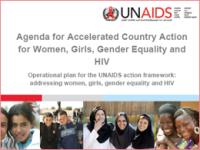UN to support civil society and governments to address gender inequalities and human rights violations that continue to put women and girls at risk of HIV infection

Credit: UNAIDS
New York/Geneva, 2 March 2010 – UNAIDS, together with celebrated artist and activist for women and HIV, Annie Lennox, has launched an Agenda for Accelerated Country Action for Women, Girls, Gender Equality and HIV (2010–2014), which has been developed to address gender inequalities and human rights violations that continue to put women and girls at risk of HIV infection.
The five-year action plan was launched at a high-level panel during the 54th meeting on the Commission on the Status of Women, being held in New York until 12 March. It calls on the UN system to support governments, civil society and development partners in reinforcing country actions to put women and girls at the centre of the AIDS response, ensuring that their rights are protected.
Violence against women is unacceptable and must not be tolerated.
Michel Sidibé, UNAIDS Executive Director
“Violence against women is unacceptable and must not be tolerated,” said Michel Sidibé, UNAIDS Executive Director. “By robbing them of their dignity, we are losing the opportunity to tap half the potential of mankind to achieve the Millennium Development Goals. Women and girls are not victims, they are the driving force that brings about social transformation.”
UNAIDS and partners will support the country roll-out of the Agenda for Action in pathfinder countries, including Liberia.
Annie Lennox underlined her unshakable commitment to the cause of women and girls affected by HIV.
“I believe we need a broad movement for change,” she said. “The bottom-line for me is that, in essence, we are all the same. All human beings, wherever we are, have the basic right to be happy and healthy. I see this Agenda for Action as a great opportunity to bring the realities faced by many women and girls to the forefront and to call attention to the injustices faced by many women and girls, placing them at a bigger risk of HIV.”
- HIV is the leading cause of death and disease among women of reproductive age (15-49 years) worldwide.
- In Southern Africa, HIV prevalence among young women aged 15–24 years is on average about three times higher than among men of the same age.
- Up to 70 percent of women worldwide encounter violence. Experiencing violence hampers women’s ability to negotiate safe sex.
As of December 2008, 33.4 million people were living with HIV worldwide, of which 15.7 million ─ almost half ─ were women. The proportion of women infected with HIV has risen in many regions over of the world over the past 10 years. In sub-Saharan Africa, 60% of people living with HIV are women. Nearly 30 years into the HIV epidemic, HIV services do not sufficiently address the specific realities and needs of women and girls.
I see this Agenda for Action as a great opportunity to bring the realities faced by many women and girls to the forefront and to call attention to the injustices faced by many women and girls, placing them at a bigger risk of HIV.
Annie Lennox
"The information on sexual and reproductive health for HIV-positive women and girls is still limited,” said Suksma Ratri, a member of Indonesia’s Positive Women’s Network, who participated in today’s launch. “Being sexually active and HIV-positive at the same time is very difficult. Women and girls living with HIV often have restricted options when it comes to their sexuality. They need an adequate and friendly support system that enables them to make free decisions about their sexuality without being discriminated and stigmatised. I think the Agenda for Action will be a good platform for countries to strengthen services for women and girls."
The Agenda for Action provides clear action points on how the UN can work together with governments, civil society and development partners to:
- produce better information on the specific needs of women and girls in the context of HIV;
- turn political commitments into increased resources and actions so HIV programmes can better respond to the needs of women and girls; and
- support leaders to build safer environments in which women’s and girl’s human rights are protected.
The actions include:
- Improving data collection and analysis to better understand how the epidemic affects women and girls.
- Reinforcing the UN Secretary-General’s UNiTE to End Violence against Women campaign through the AIDS response.
- Ensuring that violence against women is integrated into HIV prevention, treatment, care and support programmes.
- Analyzing the impact of socio-cultural and economic factors that prevent women and girls from protecting themselves against HIV.
- Supporting women’s groups and networks of women living with HIV to map commitments made by governments on women and HIV.
- Scaling up engagement of men’s and boys’ organizations to support the rights of women and girls.
The launch of the Agenda for Action involved many prominent leaders from the United Nations system, governments and civil society. Speakers included Asha Rose Migiro, United Nations Deputy Secretary-General; Melanne Verveer, US Ambassador at Large for Women’s Global Issues; Helen Clark, UNDP Administrator; and Vabah Gayflor, Liberia’s Minister of Gender and Development.



